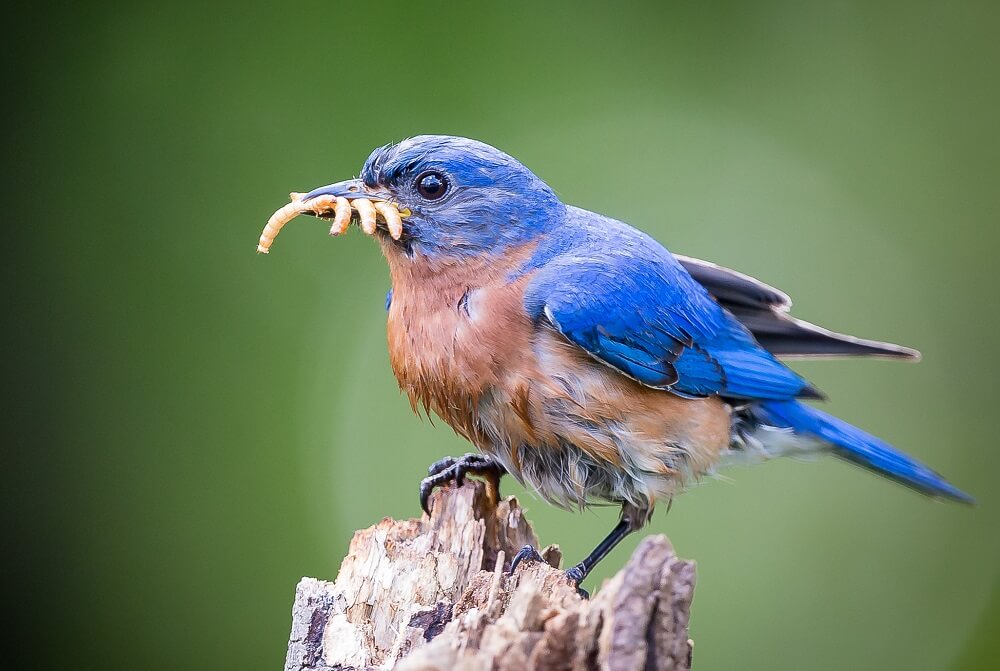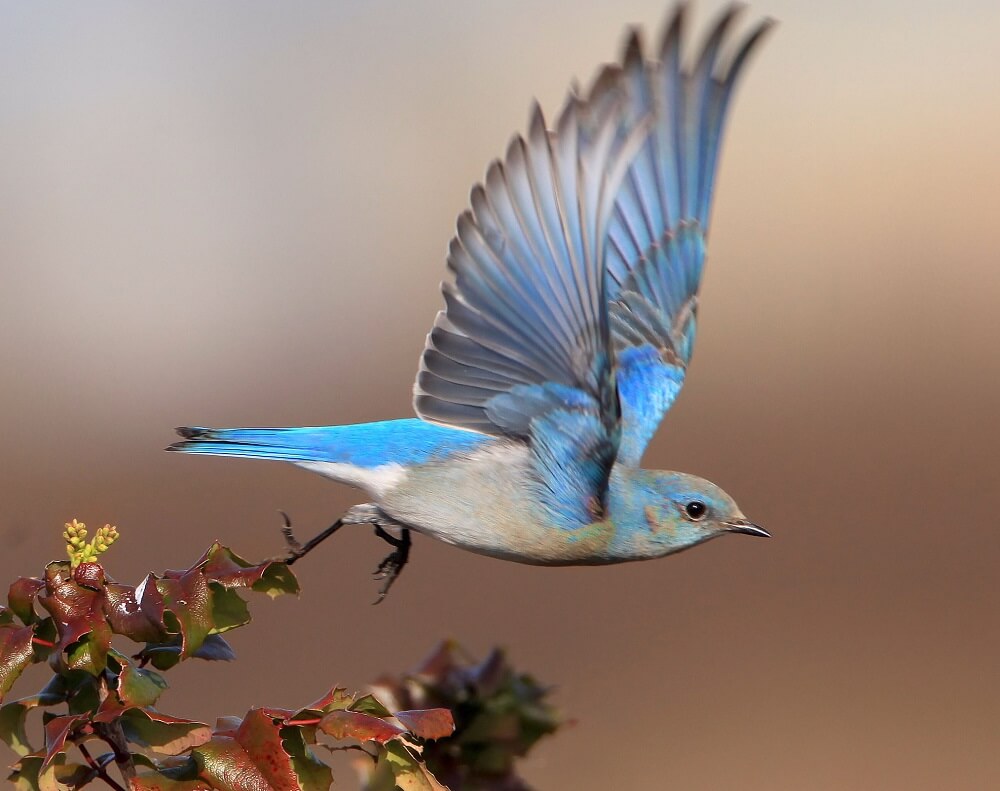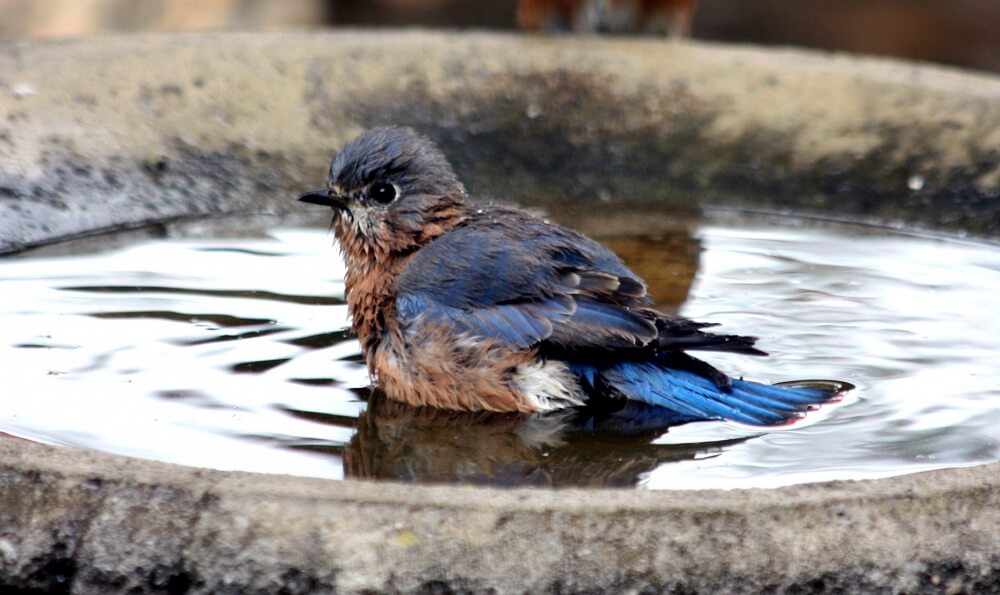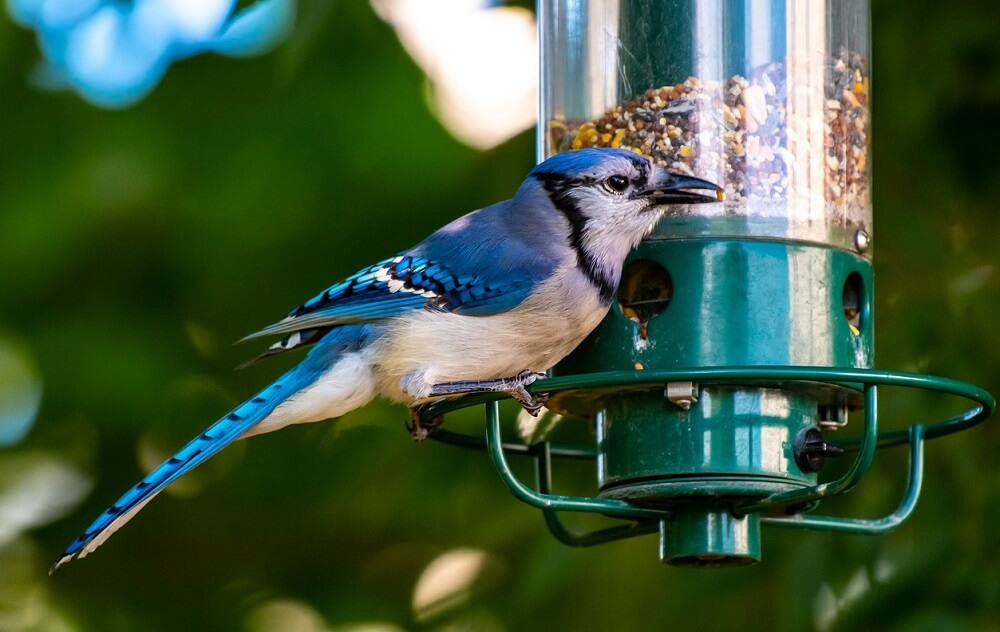Bluebirds are found across North America. In the Eastern part of the United States, Eastern Bluebirds reside.
Mountain bluebirds and Western Bluebirds are found in the west. The midwest is lucky enough to see all three species of bluebirds.
Bluebirds and their survival are directly linked to human activity. They were nearly wiped out after habitats were destroyed and pesticides killed millions of birds.
But, they have also greatly recovered with popular interest in providing them homes and the extra feedings during colder, harsher seasons.
Feeder Placement Is Vital For Attracting Bluebirds.
One of the important aspects of hanging your bluebird feeders is putting it in a place where bluebirds can find it.
Most of North America has at least one type of bluebird that’s natural to the area.
That means that,
If you don’t see bluebirds, then there are some things you can do to start attracting bluebirds to your area.
I’ll cover that later on this page.
Bluebirds usually like to stay by their nest. The female will stay by the young while the male swoops down for food.
Bluebirds don’t usually figure out how to use feeders on their own. They need help.
This is important!
You will need to place bird feeders nearby to existing bluebirds initially. This helps to train the bluebirds to come to the feeders for food.
There are several places to hang bluebird feeders to attract bluebirds.
- Hang feeders close to existing nests.
- This helps to keep the parents safe and provide a healthy meal to the babies
- Don’t keep it there long term. Move the feeder with time.
- Hang feeders under telephone wires where bluebirds perch
- Hang feeders by trees where bluebirds congregate Place bluebird feeders away from other larger-bird feeders
- Don’t place near other bird feeders
- Permanently place feeders about 100 feet away from nests
- Place near water
It’s important to know that hanging a bluebird feeder won’t make bluebirds magically come around. You will need to train them to use the feeder and to know where to find the food.
Bluebird Seasonal Diet Is Important For Attracting Bluebirds
Another important aspect of feeding bluebirds is understanding what their diet needs are during the year.
Bluebirds generally eat insects during the warmer spring and summer months. They switch to a higher calorie diet in the winter and eat mainly berries.
Did you know?
Bluebirds rarely eat seeds. They won’t be attracted to birdseed feeders.
There is a rare exception when a starving bluebird finds seed and is willing to eat.
Offering the right food is vital to attracting bluebirds.
Most people offer mealworms as a protein substitute to insects. Bluebirds love them!
Bluebird Diet During Warm Seasons
During the spring and summer, when bluebirds are raising young, they need protein for good health.
Springtime, bluebirds will also eat crushed eggshells because the females need that extra calcium for their own eggs.
Offering mealworms provides the needed protein for young birds.
They also love crickets and insects. If you feed live crickets, freeze them for a few days before feeding them.
This helps to stop them from escaping from the feeder before they can be eaten.
Bluebirds can also gain a taste for scrambled eggs- hold the salt, and suet.
- Mealworms
- Crickets
- Insects
- Suet
- Cooked eggs
- Egg shells or calcium carbonate added to mealworms for calcium supplement in the spring
Bluebird Diet During Cold Months
During the fall and winter, bluebirds switch to a high-sugar diet. They eat more berries and fruit, which help them to stay warmer.
As fall approaches, continue to offer mealworms, but start adding fruit, sunflower hearts, and berries to their feeders.
Some bluebirds will eat raisins. Raisins should be chopped. They can also be stewed to make them softer for bluebirds to eat.
As fall approaches, start mixing raisins in with the mealworms so the bluebirds can get a taste for them.
Currents, blueberries, sunflower hearts, and dogwood are other good options
Watch your bluebirds and continue to offer mealworms as long as they are being eaten. You may see that the mealworms aren’t consumed at all once the temperature gets cold enough.
Or, your local bluebirds may continue to eat small amounts of mealworms while consuming larger quantities of fruit during the cold months.
The cold weather keeps them from finding as many active insects in the winter.
You can keep mealworms and water from freezing during the winter by placing the feeder on an outdoor animal heating pad or buying a heated feeder.
Mealworm Options For Bluebirds
Live mealworms are very effective in attracting bluebirds to the feeder.
Did you know?
Mealworms aren’t actually worms!
They are the larvae of darkling beetles. The darkling beetle is a small black beetle that doesn’t cause any harm to humans.
Bluebirds that see moving mealworms are much more likely to come to the feeder. The movement will get their attention within a short timeframe.

But, freeze-dried mealworms are cheaper to purchase.
The good news?
If cost is important, you can train your bluebirds to eat freeze-dried mealworms with a little time.
Start with live mealworms. Then gradually add freeze-dried mealworms to the mix.
As the live mealworms get eaten each day, your bluebirds will start trying the freeze-dried ones.
Gradually, over a few weeks, reduce the number of live mealworms in your feeder and replace them with freeze-dried mealworms.
Your bluebirds should adjust their feeding and continue coming by for freeze-dried mealworms.
If you are also training them to come to a specific location, wait until that training is done before you switch to freeze-dried mealworms.
Or,
You can easily raise live mealworms to feed your bluebirds. You can raise mealworms for about $15 invested into the setup.
- Bluebirds need protein in the spring and summer
- Females will eat eggshells in the spring
- Bluebells need higher calories in the winter
- Berries and fruit are favorite winter food for bluebirds
- Offer mealworms all year round, but add berries during the fall and winter
- Birdseed won’t attract bluebirds to your feeders
Use The Right Type Of Feeder To Attract Bluebirds
Bluebirds don’t eat out of typical birdfeeders. They prefer open containers.
Dishes are great bluebird feeders.
But, you can also purchase bluebird feeders that protect your mealworms from larger birds.
That’s important because bluebirds won’t come to feeders that are visited by larger birds.
It will also help to keep you from spending a lot of extra money on mealworms that get eaten by hungry big birds.
There are several great bluebird feeders. I cover my favorite feeders for each type of birds on this page.
There are a few things you want to make sure your bluebird feeder has.
First, make sure that the dish for the mealworms has straight sides. It should also be made of smooth plastic, ceramic, metal, or glass.
Mealworms can’t climb up those surfaces, but they can climb up wood surfaces and other textured surfaces.
This is important because fell mealworms can attract bigger birds to your feeders and risk scaring away bluebirds or serving bluebird dinner to larger birds.
Train Bluebirds To Come To A Specific Place.
Even though you got the bluebird’s attention by placing the feeder close to their nest, you don’t want to leave it there very long.
A bluebird feeder can attract larger birds that would love to eat baby bluebirds and placing it by the nest puts the young at risk.
Wait a few days after the bluebirds have found your food. Then move if a few feet every day.
As you gradually move it to where you want it placed permanently, the bluebirds will follow.
They will be trained to come to where you can observe them.
Make sure that you follow the other rules about placing feeders found in Part 1 of this guide. It goes over how to place feeders in safe and attractive places for your birds.
Train Bluebirds To Come At Specific Times
Bluebirds can also be trained to come at certain times of the day. You shouldn’t usually offer constant food to bluebirds. I’ll cover why in the next section.
Typically, bluebird feedings are done twice a day, morning and evening. If you choose to only feed once a day, morning is the best time of the day to do it.
Bluebirds will learn to come at a specific time for their meal.
You can also train them to come to a sound such as the ringing of a bell. You can use other consistent sounds when you feed them.
- Bell
- Calling them
- Sound of a slamming door
- Whistle
It won’t take long before you will be able to know when the bluebirds are hungry from their activity and singing.
Know-How Much Food To Feed Bluebirds For Their Health
There is a little debate over whether or not bluebirds should be constantly offered food throughout the day.
Bluebirds that are offered mealworms all day long during the spring and summer are more likely to have multiple broods of young.
This helps the bluebird population to grow.

But, it also wears out the parents more. Bluebirds can live for 6-10 years.
Sadly, most bluebirds die within their first year.
So if your focus is helping the population grow, then offer free-access to mealworms all day.
But, if you are worried about the parents being more tired and worn at the end of the summer, then ration your mealworms.
Generally speaking, bluebirds should be offered 15 mealworms per bird, each day.
The National Bluebird Society recommends against offering free-style mealworms all day.
Watch how many bluebirds come to your feeder each day and adjust your quantities accordingly.
Don’t forget to continue to headcount as the spring turns to summer. Parents feeding a brood of chicks will take about 100 mealworms a day.
Add Water Near Feeders
Bluebirds, like most other birds, love water. Consider adding running water close to your bluebird perches.
The sound of running water attracts bluebirds to the area.
They are used to listening for springs, creeks, and little bubbling brooks.
The water attracts insects, which also provides food for the bluebirds.
Provide Additional Nesting Options For Bluebirds
Bluebirds are cavity nesters. They make their nests in the holes of dead trees, hollow trunks, and woodpecker cavities.
That’s one reason they love birdhouses. It provides them with the right sized hole and protection for their young.
One word of caution-
Make sure that if you want bluebirds to nest in your birdhouses, that they are the right size.
Birdhouses that are too large won’t attract bluebirds.
The openings to bluebird houses should be circular.
- 1 ½ inch in diameter for Eastern Bluebirds
- 1 9/16 inches in diameter for Western and Mountain Bluebirds
Nesting boxes should be made so that it draws cool air out in the winter and hot air out in the summer.
A birdhouse can get dangerously hot in the summer.
The National Bluebird association has several bluebird plans you can build.
Place the birdhouse in an area with semi-open grassland or country. Western bluebirds love semi-open places with scrub and brushes around.
Eastern bluebirds love grassland areas.
An open lawn, an orchard, or field all work as an area for bluebird houses.
Place bluebird nests on the east side of a tree, fence, or house to provide shade during the hot afternoon sun.
- Place nesting boxes close to open areas
- Don’t place bluebird houses closer than 125 feet from other bluebird houses.
- Bluebird boxes and Tree Swallow boxes can be placed as close as 10-25 feet to each other
- Place birdhouses on the east side of structures and trees to provide shade during hot afternoons.
- Leave dead trees alone to provide natural nesting sites for bluebirds
Protecting Bluebirds From Predators
Bluebirds can become a meal for larger birds. They can also be killed by house sparrows, pigeons, and other aggressive non-native birds.
Help to keep your bluebirds safe by monitoring your bluebird hangouts and feeders.
If bully birds are a problem, then keep them away by placing a baffle or dome over the feeder. Larger birds like pigeons don’t like a cover on their feeder and will usually stay away.
It also helps to protect bluebirds from birds of prey while they are feeding.
Place feeders away from nests for long-term protection.
Avoid spilled mealworms or berries to avoid attracting larger birds to the area.
Times Of The Year You Should Hang Bluebird Feeders
Most people assume that bluebirds are only in their area during the summer months because winter brings an absence of bluebirds.
In reality, many bluebirds winter over as far north as Ontario, the Pacific Northwest, and the Great Lakes.
But, they do often move deeper into wooded areas during the winter months.
You can help to attract and keep bluebirds in your area during the winter by providing them safe nesting boxes and winter food.
This encourages them to hang out all winter long.
Don’t forget!
If you start feeding bluebirds in the fall and winter, you should continue it all winter long.
This should be a commitment.
Keeping bluebirds from moving to other safe-food rich areas can cause them to starve to death if you stop feeding them.
Human habits play heavily into bluebird survival.
Conclusion
Try these tips and you will enjoy watching bluebirds all summer and into the fall. You might also want to check out the next article on how to attract robins to your yard.
Related Articles:



